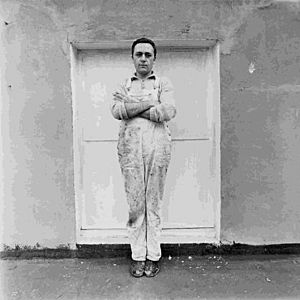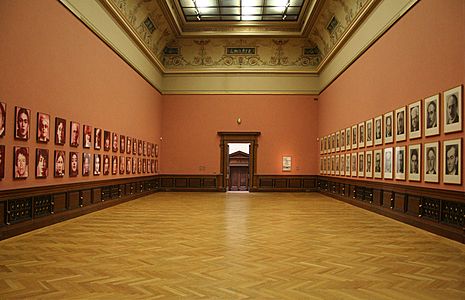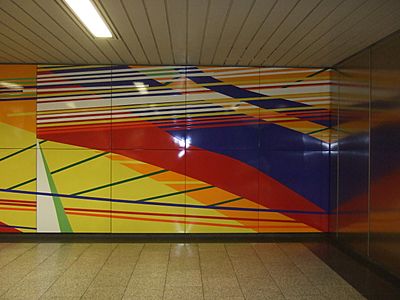Gerhard Richter facts for kids
Quick facts for kids
Gerhard Richter
|
|
|---|---|
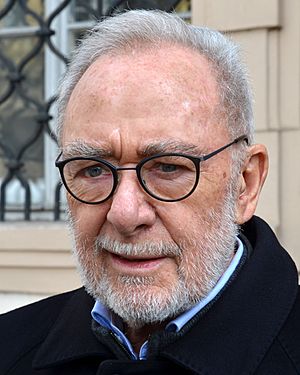
Richter in 2017
|
|
| Born | 9 February 1932 Dresden, Germany
|
| Education | Dresden Art Academy, Kunstakademie Düsseldorf |
| Known for | Painting |
| Movement | abstract art, photo realism, conceptual art, capitalist realism |
Gerhard Richter (born 9 February 1932) is a famous German artist. He creates many different kinds of art, including abstract paintings (which don't show real objects) and photorealistic paintings (which look like photos). He also works with photographs and glass.
Many people consider Richter one of the most important German artists alive today. His artworks have sold for very high prices, and at one point, he was the most expensive living painter. Some have even called him "the greatest living painter" or the "Picasso of the 21st century."
Contents
About Gerhard Richter
His Early Life and School
Gerhard Richter was born in Dresden, Germany. He grew up in small towns in the countryside. His father was a village teacher, and his mother loved books and music.
During World War II, when Gerhard was a child, his family moved to Waltersdorf. Sadly, some of his family members died during the war. His aunt Marianne, who had a mental illness, was a victim of the Nazi government's cruel programs.
Richter left school after 10th grade. He first trained to be a painter for advertisements and theater sets. Later, he studied art at the Dresden Academy of Fine Arts, starting in 1951.
Family Life
Gerhard Richter has been married three times. He married Marianne Eufinger in 1957, and they had a daughter. In 1982, he married sculptor Isa Genzken. Later, in 1995, he married Sabine Moritz, and they had two sons and a daughter.
Starting His Art Career
Early in his career, Richter created large wall paintings for his art academy and the German Hygiene Museum. These paintings were part of his studies.
From 1957 to 1961, Richter worked as a trainee at the academy. He took on art projects for East Germany, which was a separate country at the time. He painted murals, oil paintings, and self-portraits.
In 1961, Richter and his wife Marianne moved from East Germany to West Germany. This happened just two months before the Berlin Wall was built. Because they left, his wall paintings in East Germany were covered up. Years later, after Germany became one country again, parts of one of his murals were uncovered and restored.
In West Germany, Richter continued his art studies in Düsseldorf. He worked with other artists like Sigmar Polke. Together, they came up with the art term "Capitalistic Realism." This was a playful way to describe art that used images from advertising. It also commented on the art style called "Socialist Realism" from the Soviet Union.
Richter later became a professor at the Kunstakademie Düsseldorf, teaching art for over 15 years. In 1983, he moved to Cologne, where he still lives and works today.
Gerhard Richter's Art
Photo-Paintings and the "Blur"
In the 1960s and early 1970s, Richter started making paintings based on black-and-white photographs. He used pictures from newspapers, books, and even his own snapshots. He painted cityscapes, seascapes, and portraits.
He often painted portraits of people he knew, like his daughter Betty and his second wife, Isa Genzken. Many of his realistic paintings also explored the history of Nazism, showing family members who were involved or affected by it.
Richter also made prints from 1965 to 1974. He used different printing methods to make his art look less "artistic" and more like everyday images.
Landscapes and Atlas
Richter began painting landscapes in 1968 after a trip to Corsica. His landscapes are often compared to traditional German Romantic paintings, especially those by Caspar David Friedrich. Both artists spent important years in Dresden.
Atlas is a huge, ongoing art project that Richter started in 1972. It's like an encyclopedia made of about 4,000 photographs, reproductions, and cut-out images. These are grouped together on many separate panels.
In 1972, Richter traveled to Greenland and later created four large paintings called Seascape based on his photos from the trip.
Still Life and Historical Paintings
In the early 1980s, Richter created a series of paintings of Candles and Skulls. These artworks remind us of old paintings called memento mori, which mean "remember you must die." They make us think about life, silence, and death. One of his candle paintings was even reproduced on a huge scale in Dresden to mark the 50th anniversary of the city's bombing during World War II.
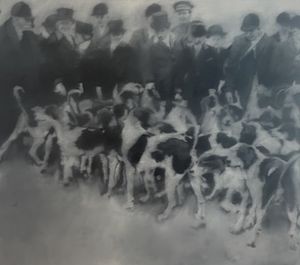
In 1988, Richter created a series of 15 paintings called 18 October 1977. These paintings were based on black-and-white newspaper and police photos of members of a German group called the Red Army Faction. The paintings explored a controversial historical event.
Since 1989, Richter has also made new images by dragging wet paint over photographs. These photos are often everyday snapshots of family, friends, and places.
After the 9/11 attacks in 2001, Richter made a small painting called September (2005) about the planes crashing into the World Trade Center. This painting explores how we remember big events when there are so many photos of them.
In the 2000s, Richter also created art inspired by science. His Silicate paintings, for example, show patterns based on reflections from insect shells.
In 2014, Richter created a powerful series of four paintings called Birkenau. These works were inspired by photographs taken in the Auschwitz-Birkenau concentration camp during the Holocaust, a very sad time in history. These paintings are now on permanent display near the Auschwitz II-Birkenau site.
Abstract Art
Richter's abstract paintings don't show recognizable objects. He builds up many layers of paint, using brushes and a special tool called a squeegee to spread and scrape the paint. This creates interesting textures and patterns.
He started calling his works Abstract Painting in 1976. He felt this allowed the art to "come" on its own, rather than him forcing it. Even though his abstract works use unusual colors and show the marks of his tools, they often feel like windows looking out into a landscape.
In the mid-1980s, Richter began using a homemade squeegee to create vertical columns of paint on his canvases. His abstract works often combine spontaneous actions with careful planning.
Firenze is a series of small paintings from 1999 that combine images of Florence with overpainted elements. These are part of his larger collection of "overpainted photographs."
After 2000, Richter continued to explore scientific ideas in his abstract art. In 2006, he created six large abstract paintings called Cage, named after the composer John Cage. These works feature intersecting fields and smears of paint.
In 2002, Richter photographed 216 details of one of his abstract paintings. He combined these small images with texts about the Iraq war from a German newspaper. This work was published as a book called War Cut in 2004.
Color Chart Paintings
Richter started making paintings based on color charts in 1966. These works arrange rectangles of colors in many different ways. He was inspired by how these charts showed an endless variety of hues.
His experiments led to large paintings like 256 Colours (1973-74). He used mathematical systems to mix colors and even used chance to decide where each color would go. This allowed him to separate color from any traditional meaning.
In 2007, Richter created 4900 Colours, which consists of bright monochrome squares arranged randomly in a grid. This work was made at the same time he designed a stained-glass window for the Cologne Cathedral.
Sculpture and Glass Art
Richter began working with glass in 1967, creating pieces like Four Panes of Glass. These glass sheets could be tilted at different angles.
In 1981, he started making large transparent mirrors. These mirrors are much bigger than his paintings and can change how you see the space around them. He also created sculptures like Kugel (Sphere) in 1992, which is a stainless steel sphere that acts like a mirror. Since 2002, he has made three-dimensional glass constructions, such as 6 Standing Glass Panels.
Drawings
In 2010, an exhibition called Lines which do not exist showed Richter's drawings from 1966 to 2005. Some of these drawings were made using unusual methods, like attaching a pencil to an electric hand drill. This showed his interest in how art is made, even if it doesn't look "perfect."
Special Art Projects
Richter has taken on a few special art projects throughout his career. For example, his painting Domplatz, Mailand (1968), which shows the Milan Cathedral, was a special request from a company.
In 1998, he created a wall piece based on the colors of Germany's flag for the rebuilt Reichstag building in Berlin. In 2017, he even designed the label for a famous French wine bottle.
Church Windows
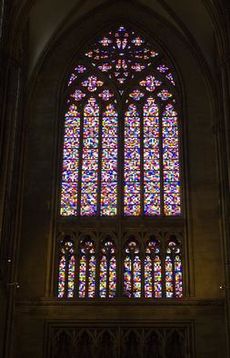
In 2002, Richter was asked to design a stained-glass window for the famous Cologne Cathedral. His window, unveiled in 2007, is a huge abstract collage of 11,500 pixel-like squares in 72 colors. These colors are arranged randomly by a computer, similar to his earlier painting 4096 Colours. Richter did not charge for his work, and the window was paid for by donations.
In 2020, Richter unveiled three large stained-glass windows for the Tholey Abbey, one of Germany's oldest monasteries. He called these his last major works, saying he would focus on drawings and sketches from then on. These windows are abstract and inspired by his "Pattern" series.
Exhibitions
Gerhard Richter first started showing his art in Düsseldorf in 1963. His first solo show was in 1964. By the early 1970s, his art was shown frequently across Europe and the United States.
His first big exhibition looking back at his career was in 1976. In 2002, a major exhibition covering 40 years of his work was held at the Museum of Modern Art in New York and traveled to other museums in the US.
Richter's art is now part of the permanent collections in many museums around the world. He has also participated in important international art shows like the Venice Biennale and Documenta.
The Gerhard Richter Archive was created in 2005 to help preserve his work. In 2020, he started the Gerhard Richter Art Foundation to make his art available for exhibitions.
Gallery
-
Gerhard Richter & Isa Genzken, Wall-art in underground, Duisburg, 1980–1992, in colorful enamel plates
-
Gerhard Richter, Cologne Cathedral Window, around 2007, light-fall from the stained-glass window in the Kölner Dom
Awards and Influence
Richter has received many important awards throughout his career. These include the Praemium Imperiale from Japan, the Golden Lion from the Venice Biennale, and the Wolf Prize from Israel. In 2007, he was made an honorary citizen of Cologne.
Many artists have been influenced by Richter, including Thomas Struth and Thomas Schütte, who were his students.
Richter's art has also inspired writers and musicians. The band Sonic Youth used one of his paintings for the cover of their album Daydream Nation in 1988. A short story by Don DeLillo called "Baader-Meinhof" describes a meeting in a museum room displaying Richter's 18 October 1977 paintings.
For the last 18 years, Gerhard Richter has been ranked as the number one most important artist in the world by a German magazine called Capital.
Art Market Position
Gerhard Richter's artworks are highly valued in the art market. Museums own about 38% of his works, including many of his large abstract paintings. His works are also frequently sold at auctions for very high prices.
For example, his candle paintings were among the first to sell for millions of dollars. In 2008, his painting Kerze (Candle) sold for $15 million. His abstract paintings also fetch high prices. In 2012, one of his abstract canvases, Abstraktes Bild (809–4), sold for $34.2 million.
In 2013, his 1968 painting Cathedral Square, Milan sold for $37.1 million. In 2015, his 1986 painting Abstraktes Bild (599) sold for $44.52 million, which was the highest price for a piece of contemporary art at auction at that time.
When asked about these incredibly high prices, Richter has said it's "impossible to understand and it's daft!"
Films About Gerhard Richter
Several films have been made about Gerhard Richter's life and work. In 2003, Gerald Fox made a documentary about him. In 2011, Corinna Belz released a feature-length documentary called Gerhard Richter Painting, which showed the artist creating his large abstract works in his studio.
The 2018 drama film Never Look Away is inspired by Richter's life story. Richter has also collaborated on films with Corinna Belz that combine his art with music by composers like Marcus Schmickler and Steve Reich.
See also
 In Spanish: Gerhard Richter para niños
In Spanish: Gerhard Richter para niños
- Wand (Wall)
- Birkenau series


